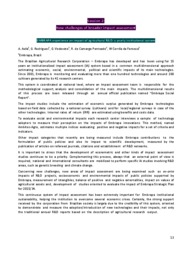EMBRAPA experience on impact of agricultural R&D: a yearly institutional system.
EMBRAPA experience on impact of agricultural R&D: a yearly institutional system.
Author(s): AVILA, A. F. D.; RODRIGUES, G. S.; VEDOVOTO, G. L.; PENTEADO FILHO, R. de C.; FONSECA JUNIOR, W. C. da
Summary: The Brazilian Agricultural Research Corporation ? Embrapa has developed and has been using for 15 years an institutionalized impact assessment (IA) system based in a common multidimensional approach estimating economic, social, environmental, political and scientific impacts of its main technologies. Since 2001, Embrapa is monitoring and evaluating more than one hundred technologies and around 200 cultivars generated by its 41 research centers. This system is coordinated at national level, where an impact assessment team is responsible for the methodological support, analysis and consolidation of the main impacts. The multidimensional results of this process are been released through an annual official publication named ?Embrapa Social Report?. The impact studies include the estimation of economic surplus generated by Embrapa technologies based on field data collected by a national survey (cultivars) and for local/regional surveys in case of the other technologies. Internal rates of return (IRR) are estimated using benefits and costs data. To evaluate social and environmental impacts each research center interviews a sample of technology adopters to measure their perception on the impacts of Embrapa innovations. This method, named Ambitec-Agro, estimates multiple indices evaluating positive and negative impacts for a set of criteria and indicators. Other impact categories that recently are being measured include Embrapa contributions to the formulation of public policies and also its impact to scientific development, measured by the publication of articles on refereed journals, citations and establishment of R&D networks. It is important to stress that the development of econometric and other kinds of impact assessment studies continues to be a priority. Complementing this process, always that an external point of view is required, national and international consultants are mobilized to perform specific IA studies involving R&D areas, such as genetic breeding and climate change. Concerning new challenges, new areas of impact assessment are being examined such as ex-ante impacts of R&D projects, socioeconomic and environmental impacts of public policies supported by Embrapa, measurement of intangibles, balance of positive and negative externalities, impact on values of agricultural assets and, development of studies oriented to evaluate the impact of Embrapa Strategic Plan for 2015/34. This continuous system of impact assessment has been extremely important for Embrapa institutional sustainability, helping the institution to overcome several economic crises. Certainly, the strong support received by the corporation from Brazilian society is largely due to the credibility of this system, oriented to demonstrate and measure the adoption/introduction of new technologies and their impacts, not only the traditional annual R&D reports based on the description of agricultural research output.
Publication year: 2015
Types of publication: Abstract in annals or event proceedings
Unit: Embrapa Environment
Keywords: Avaliação de impacto, Pesquisa agropecuária
Observation
Some of Embrapa's publications are published as ePub files. To read them, use or download one of the following free software options to your computer or mobile device. Android: Google Play Books; IOS: iBooks; Windows and Linux: Calibre.
Access other publications
Access the Agricultural Research Database (BDPA) to consult Embrapa's full library collection and records.
Visit Embrapa Bookstore to purchase books and other publications sold by Embrapa.

